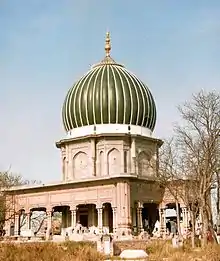
Syed Haji Muhammad Naushah (نوشہ) Ganj Bakhsh Qadiri (also spelled Qadri, 21 August 1552 – 18 May 1654), a scholar, saint and preacher of Islam in South Asia (today's Mandi Bahaudin District, Pakistan),[1][2] was the founder of the Naushahia branch of the Qadiriyya Sufi order. He preached in the tenth and eleventh centuries AH (sixteenth and early seventeenth centuries AD). His adherents call themselves Qadri Naushahi, Naushahi or just Qadri (Qadiri).
Birth and names
Syed Muhammad Naushah Ganj Bakhsh Qadri was born on the first of Ramadan in 959 AH (21 August 1552) at Ghogganwali, district Mandi Bahaudin in Punjab, Pakistan. His father, Syed Ala’uddin Gilani Qadiri, was a Sufi.
At his birth he was named Muhammad and later on he also was known by the names of Haji Nausha, Abul Hashim, Bhoora Wala Pir (the enshrouded one), Mujaddid-i Islam (the great revival of the Islam), Naushah Ganj Bakhsh, Syed Naushah Pir and Naushah Pak. The name Naushah is also spelled and pronounced as Noshah or even Nosho.
Forebears
Haji Muhammad Qadri was a Sayyid (direct descendant of Ahl-e-Bait of Muhammad), a 25rd generation scion of Ali Ibn Abi Talib.
Golden Chain
At the age of twenty-nine years Muhammad accepted Shah Sulaimān Nūri as his spiritual guide, placing him in a silsila (spiritual order or chain of saints) that stretched back to Abdul Qadir Jilani.
Personal life
Haji Muhammad was married to the daughter of Sayyid Abu Nasr Fateh Muhammad Shah of Qutb Naushehra. His mother, Main Jīwnī, arranged this marriage. He had two sons and one daughter. Their names were Sayyid Muhammad Barkhurdar, Sayyid Muhammad Hashim and Sayyida Sairah Khatoon.
Literary works
The following works have been published:
- Kulliyāt-i Naushāh: (Urdu poetry) consisting of 76 Risala's and 2400 verses.
- Kulliyāt-i Naushāh: (Punjabi poetry) In this work 126 Risala's of about four thousand verses are alphabetically arranged.
- Ma‘ārif-i Tasawwuf: (Persian poetry) dealing with assignments on the spiritual path.
- Mawā'iz-i Naushāh Pīr: (Punjabi prose) comprises delivered speeches and advices.
Quotations
"O friend, withdraw yourself from the world."
"If you don't, you have once to do that."
"Don't spoil your time of life."
"Leave the fame of the world behind you."
"O my true friend, follow your Murshid (guide)."
"Do this in sincere surrendering in the heart with belief."
"Commemorate the Kalima, so that you will not lose it."
"The sufferings of this world and the last moment [death]."
"You can only prevail by this!"
Death
Haji Muhammad died of natural causes on Monday, the fifteenth of the Islamic month Rabī 'ul-Awwal 1064 AH, aged one hundred and one. This date corresponds to Monday the eighteenth May 1654 A.D. He was buried in the village named Naushehra in Gujrat. His body was later interred at Ranmal Sharif in Mandi Bahaudin. His grave is open to the public. The part of land on which his grave has been buried, belongs to the territory of Ranmal Sharif. The number of plot was formerly 220 and at the present 84/1.
Due to flooding in 1757 his body was transferred from its original burial site. According to tradition, when his coffin surfaced, his body was entirely intact, even his shroud was unharmed. After being damaged again by the river Chenab his coffin was finally moved to the west of Sahanpal Sharif. In 1950 this new tomb was damaged by rain. Consequently, the supports subsided and cracks appeared in the tomb. His death anniversary ('Urs) is held at this place every year again. Urs starts on 2nd Thursday of Har (Bikrami Calendar), which falls in the last 10 days of June and usually lasts 3 days. Thursday and Friday for men and Saturday for women.
Sadaat E Noshahia
Noshahi, Noushahi, Noshahi Qadiri, is a sub branch of Hassani Sadaat the decedents of grand-son of the Islamic Prophet Muhammad . The name is used by the progeny of Syed Muhammad Nosha (Noshah pak) also spelled as Nosho pak. The word Pir, Faqir is also used by the descendants of Nosho pak to distinguish them from the followers who also use the word Noshahi to show their "Nisbat" to the Hazrat Muhammad Noshah Ganj Baksh.
References
- ↑ "Jamiyat Tablighul Islam - Home". www.jamiyattablighulislam.org. Archived from the original on 10 October 2007. Retrieved 12 January 2022.
- ↑ Abu Matlub Qadiri Naushahi Fayzan-e Naushah 2018 ISBN 978-94-92185-80-8
External links
- SILSILA QADRIA NAUSHAHIA
- FAYZAN-E NAUSHAH Second Edition – Biographies of the spiritual masters and saints of the Qādiriyah Naushāhiyah Order
- Jamiyat Tablighul Islam - Home
- Genealogy from Naushahi 17/02/06 - - PhpGedView – Up-to-date Family Tree of Muhammad Naushah Ganj Bakhsh Qadri
| Part of a series on Islam Sufism |
|---|
 |
|
|